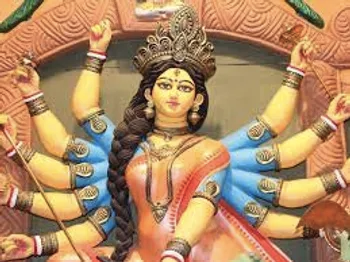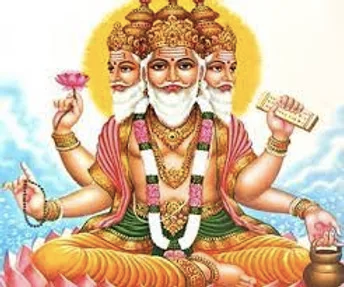At some point in your yoga practice, you will inevitably encounter an Indian deity in one form or another. Be it the symbol or name behind your local yoga studio, an image on the wall, or a mantra chanted in class, Indian deities are an intrinsic part of yoga. Abstract concepts are difficult for just about everyone to understand. The Indian deities offer a solution to this. They put a face on abstract concepts such as abundance, love, and knowledge that are often so hard for us to fully understand.
Mythology provides us with moral, spiritual, and natural images of the world through which we can tune our physical, mental, emotional, and spiritual bodies. Each deity personifies particular energies we can channel through various practices such as chanting or visualization. Everything about them – from the stories of their lives to the color of their skin and the items they carry is embedded in rich energetic symbolism designed to open our hearts and raise our vibrations.
Why tragic? When we blame, it can be a way of reclaiming our own power, to mobilize our inner strength for the sake of protecting ourselves or what is dear to us. I remember recently watching a documentary about an Iranian women’s rights activist and her powerful and fiery speech on-air, blaming a representative of a repressive regime. Sometimes this force is an expression of life in us, our anger, our desperation. It can serve as a wake-up call.
As we saw in the last post, “The Secret to Happiness: How Yoga Builds Better Mental Health,” our thoughts have a profound impact on our health and ultimately create our realities.
Through visualizing or chanting to deities that embody righteous qualities, we subconsciously create positive new neurological patterns associated with them. To put it more simply, “your vibe attracts your tribe.”
The energies you tune into will ultimately manifest in your life one way or another.
So how do you apply this?
Well, consider what you’d like to see change in your life or what you’d like to manifest. It’s said there are as many deities as there are devotees, so no matter what you’re looking for, an energetic solution exists. To better understand this, let’s take a look at 9 common deities, the energies they personify, as well as some fun facts about them!
“If you want to understand the secrets of the universe, think in terms of energy, frequency, and vibration”
– Nikola Tesla
Hindu God of Shiva
Energy: Consciousness, introspection, meditation
Fun Facts:
- Referred to as Adi Yogi, or the first Yogi
- Commonly depicted smeared in ashes, with 3 eyes, matted hair, and 4 arms. He is adorned in snakes and skulls and has a blue throat, representing that he has conquered the ego and poisons of the manifest world. It is said that Maya, or illusion, exists when Shiva only has 2 eyes open, the eyes of duality. When his third eye opens, he sees only unity.
- Nataraja, the cosmic dancer, is one of Shiva’s energies. The yoga posture Natarajasana is named after him.
- Basic Mantra: oṃ namaḥ śivāya
Think calm, cool, collected, laid-back “dude.” Shiva is confident in the knowledge of who he is, which is why the Yoga Yajnavalkya corresponds his energy to the Manipura chakra, our center of fire, courage, and confidence. On days when you need a confidence booster or to turn inwards, chant and channel Shiva’s meditative energy.

Hindu God Vishnu
Energy: Preservation, protection, peace, and healing
Fun Facts:
- Vishnu is blue (as are many deities). He is blue the way the sky or the ocean is blue. Air and water are colorless, their particles simply vibrate at the frequency of the color blue caught from sunlight, which is a mixture of all the colors of the rainbow. In the same way, the image of the deity is nothing more than a frequency and an optical illusion. This is used as a reminder that they are energies of something greater.
- Ram from the Ramayana, Krishna from the Mahabharata, and even the Buddha are said to be reincarnations of his energy.
- Basic Mantra: oṃ namo nārāyaṇāya
Think of the captain of the football team, Prince Charming, or Superman. Vishnu steps in to save the day. He is said to watch over the earth and reincarnate when trouble’s at bay. Tune into his energy for protection, peace, and healing.

Parvati / Shakti
Energy: marriage, motherhood, love, children and harmony
Fun Facts:
- This mother goddess is the wife and shakti of Shiva. She is associated with nature and the earth.
- Shakti is the Sanskrit term for primordial cosmic energy. It is the potential energy available to all and within all; ready to be tapped and manifested. It is the burning power of fire and the flowing energy of a river; the inherent energy behind everything.
- Parvati means “daughter of the mountains” as she is considered the daughter of the Himalayas.
- A majority of Indian goddesses such as Durga (below) and Kali are aspects of her.
Think grounded, nurturing flower child. Connect to Parvati through Mother Earth. Spend time in nature, and ground, and remember no matter where you are, you are always supported by the earth beneath you.

Hindu Goddess Durga
Energy: Protection and strength
Fun Facts:
- She has 8 arms, each of which holds a weapon to protect those who channel her energy
- Many deities have multiple arms signifying their ability to multitask. More importantly, they can symbolize that we can accomplish far more when we tune into higher energies!
- Durga means “one who is difficult to approach”
- Basic Mantra: oṃ duṃ durgāye namaḥ
Think biker chic or Goddess pose; strong and stable, ready to conquer any demons that come your way. Chant to Durga for protection and the strength to face your fears!

Want to learn more about how to utilize mythology and energy in your practice? Join our 300hr Yoga Teacher Training and enhance your yogic toolbox.
Goddess of Lakshmi
Energy: wealth, prosperity, beauty, and abundance
Fun Facts:
- Lakshmi is associated with the colors yellow, gold, and red as they symbolize wealth and prosperity.
- She is the wife and shakti (energy) of Vishnu
- She is often associated with the lotus, or padma, due to her beauty and poise. The purity of the lotus, despite arising from the mud, balances beautifully on water, calm and unaffected. It symbolically represents balance, growth from struggle, and the ability to flow through life unaffected by the circumstances.
- Basic Mantra: oṃ ṣrīṃ mahā lakṣmīyai namaḥ
Chant to Lakshmi to connect with the divine principle of abundance or to remove the burdens that come with monetary wealth.

Hindu Goddess Saraswati
Energy: learning, knowledge, speech, fertility, the arts and culture
Fun Facts:
- Saraswati means, “the flowing one.” She is represented in the Rig Veda as a river.
- She is usually depicted as pure white and dressed in white.
- Mantras to her are often recited in schools throughout India
- She is the wife and shakti of Brahma, the Creator
Channel Sarasvati’s energy for scholarly strength, knowledge, and creative energy.

Hanuman
Energy: strength, devotion, courage and self-discipline
Fun Facts:
- Hanumanasana, the yoga pose that involves a front split, is named after this powerful monkey deity.
- A key player in the Ramayana and devotee of Ram, he is deemed the perfect servant, a symbol of devotion.
- Called Pavana Putra or Vayu Suta, Hanuman is the son of the wind, known for his superhuman strength
- Basic Mantra: oṃ śrī hanumate namaḥ
Need a little extra strength or energy in your yoga practice? Chant to Hanuman for strength, courage, vitality, and devotion!

Ganesha
Energy: Good luck; success in new tasks; grounding; happiness and clarity
Fun Facts:
- Ganesha is the elephant-faced son of Shiva & Parvati
- He represents the energies of our root chakra. The remover of obstacles, this cute little elephant is a symbol of solid foundations and beginnings free of obstruction.
- Basic Mantra: oṃ gaṃ gaṇapataye namaḥ
Chant to Ganesha’s energy to begin auspicious events or at the start of new endeavors to ensure they go smoothly and worry-free.

Brahma
Energy: Creation
- Brahma is the Creator in the Hindu Trimurti or trinity.
- On a molecular level manifestation occurs when 1 neutron splits to form a proton and electron, it then decays and a proton is converted into a neutron and electron. It is the nature of matter to manifest and dissolve like this; an infinite process of creation, preservation, and destruction. The Trimurti represents this cycle. Brahma embodies the energy of creation, Vishnu the energy of preservation, and Shiva the energy of destruction.
- He has 4 heads representing the 4 Vedas (ancient spiritual text) and the 4 cardinal directions.
- Brahma is the least worshiped deity in the Trimurti.

So, what energy do you attract? Whose vibes will you channel?
You can also check out Benjamin Collin’s Podcast series, Vedic Mythology, Music, and Mantras for fun stories surrounding Indian mythology.
Avoid these common mistakes: Your Guide to Picking the Right YTT





